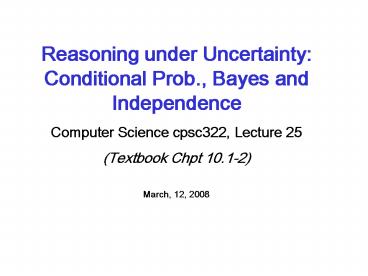Reasoning under Uncertainty: Conditional Prob', Bayes and Independence - PowerPoint PPT Presentation
1 / 19
Title:
Reasoning under Uncertainty: Conditional Prob', Bayes and Independence
Description:
Reasoning under Uncertainty: Conditional Prob., Bayes and Independence ... The conditional probability of formula h given evidence e is ... – PowerPoint PPT presentation
Number of Views:50
Avg rating:3.0/5.0
Title: Reasoning under Uncertainty: Conditional Prob', Bayes and Independence
1
Reasoning under Uncertainty Conditional Prob.,
Bayes and Independence Computer Science cpsc322,
Lecture 25 (Textbook Chpt 10.1-2) March, 12, 2008
2
Lecture Overview
- Recap Semantics of Probability
- Marginalization
- Conditional Probability
- Chain Rule
- Bayes' Rule
- Independence
3
Recap Possible World Semanticsfor Probabilities
Probability is a formal measure of subjective
uncertainty.
- Random variable and probability distribution
- Possible world.
- Probability of a proposition f
4
Joint Distribution and Marginalization
Given a joint distribution, we can compute
distributions over smaller sets of variables
5
Why is it called Marginalization?
6
Lecture Overview
- Recap Semantics of Probability
- Marginalization
- Conditional Probability
- Chain Rule
- Bayes' Rule
- Independence
7
Conditioning (Conditional Probability)
- Probabilistic conditioning specifies how to
revise beliefs based on new information. - You build a probabilistic model taking all
background information into account. This gives
the prior probability. - All other information must be conditioned on.
- If evidence e is all of the information obtained
subsequently, the conditional probability P(he)
of h given e is the posterior probability of h.
8
Conditioning Example
- Prior probability of having a cavity
- P(cavity T)
- Should be revised is you know that there is
toothache - P(cavity T toothache T)
- It should be revised again if you were informed
that the probe did not catch anything - P(cavity T toothache T, catch F)
9
Conditional probability (irrelevant evidence)
- New evidence may be irrelevant, allowing
simplification, e.g., - P(cavity toothache, sunny) P(cavity
toothache) - We say that Cavity is conditionally independent
from Weather (more on this next class) - This kind of inference, sanctioned by domain
knowledge, is crucial in probabilistic inference
10
Semantics of Conditional Probability
- Evidence e rules out possible worlds incompatible
with e. - We can represent this using a new measure, µe(w)
over possible worlds
- The conditional probability of formula h given
evidence e is
11
Semantics of Conditional Probability Example
e (cavity T)
P(h e) P(toothache T cavity T)
12
Conditional Probability among Random Variables
P(X Y) P(toothache cavity)
P(toothache ? cavity) / P(cavity)
13
Chain Rule
- Definition of conditional probability
- P(X Y) P(X ? Y) / P(Y)
- Product rule gives an alternative, more intuitive
formulation - P(X ? Y) P(X Y) P(Y) P(Y X) P(X)
- Chain rule is derived by successive application
of product rule - P(X1, ,Xn)
- P(X1,...,Xn-1) P(Xn X1,...,Xn-1)
- P(X1,...,Xn-2) P(Xn-1 X1,...,Xn-2) P(Xn
X1,...,Xn-1) . - P(X1) P(X2 X1) P(Xn-1 X1,...,Xn-2)
P(Xn X1,.,Xn-1) - ?ni 1 P(Xi X1, ,Xi-1)
14
Chain Rule Example
- P(cavity , toothache, catch)
15
Lecture Overview
- Recap Semantics of Probability
- Marginalization
- Conditional Probability
- Chain Rule
- Bayes' Rule
- Independence
16
Bayes' Rule
- Product rule P(a?b) P(a b) P(b) P(b a)
P(a) - Bayes' rule P(a b) P(b a) P(a) / P(b)
- or in distribution form
- P(YX) P(XY) P(Y) / P(X)
- Useful for assessing diagnostic probability from
causal probability - P(CauseEffect) P(EffectCause) P(Cause) /
P(Effect) - E.g., let M be meningitis, S be stiff neck
- P(ms) P(sm) P(m) / P(s) 0.8 0.0001 / 0.1
0.0008
17
Marginal Independence
DEF. Random variable X is marginal independent of
random variable Y if, for all xi ? dom(X), yk ?
dom(Y), P( X xi Y yk) P(X xi ) That is,
your knowledge of Ys value doesnt affect your
belief in the value of X Consequence P( X xi ,
Y yk) P( X xi Y yk) P( Y yk) P(X xi
) P( Y yk)
18
Marginal Independence Example
- A and B are independent iff
- P(AB) P(A) or P(BA) P(B) or P(A, B)
P(A) P(B) - That is new evidence B (or A) does not affect
current belief in A (or B) - Ex P(Toothache, Catch, Cavity, Weather)
- P(Toothache, Catch, Cavity) P(Weather)
- JPD requiring 32 entries is reduced to two
smaller ones (8 and 4)
19
Next Class
- Marginal Independence
- Conditional Independence
- Belief Networks.































